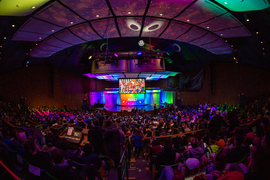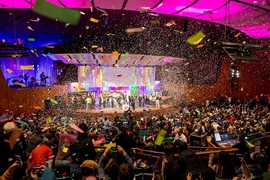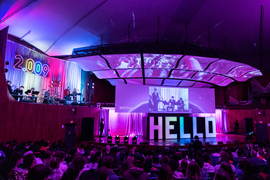Things got “WILD!” in Kresge auditorium on Monday night — that was the theme for this year’s class 2.009 (Product Engineering Processes) senior capstone course, and it’s also a great word to describe of the energy of the capacity crowd gathered for the course’s annual product prototype launch event.
The popular mechanical engineering course, known on campus as “two-double-oh-nine,” is designed to emulate what engineers might experience as part of a design team at a modern product development firm. Working with mentors, teams of students are challenged to design, build, and draft a business plan for a product prototype. They’re given a budget of $7,500 and just three months to bring their concepts to fruition before pitching to a live audience on MIT’s largest stage. The event also attracts a global audience of thousands watching live online.
This year’s theme invited teams to imagine products that could help end users with a diversity of "wild" experiences — from enabling them to engage more safely in risky sports or activities to creating more freedom from physical constraints. The six teams, each represented by a color, delivered with products that ranged from a health-care solution to a home crafting system to a track cleaner for mass transit systems.
Throughout the night, spectators in Kresge cheered and waved colorful pompoms as teams demonstrated their prototypes and shared business plans, pitching their products with stories and elaborate sets, backdrops, and props.
Between presentations, animated shorts entertained viewers, video montages showed the “wild” events of the semester, and a live band performed pun-filled renditions of popular songs like Dua Lipa’s “Dance the Night,” but with lyrics substituted to reflect 2.009 concepts, like “watch us build!” and “we design, we design, we design!”
In one special musical interlude, the band played Neil Diamond’s “Sweet Caroline” to celebrate longtime 2.009 and Pappalardo Lab staff member Stephen Haberek, who is retiring after 29 years at MIT. Haberek and course instructor Professor David Wallace (who donned several costumes throughout the evening, but was then dressed as Max from Maurice Sendak’s classic children’s book “Where the Wild Things Are”) danced as the crowd sang along. Wallace returned as event emcee following a sabbatical last year. He has instructed 2.009 since 1995.
Purple Team
In the first pitch of the night, the Purple Team presented their prototype for “Sway,” a medical bed attachment and sheet system designed to aid nurses in patient repositioning. The students explained that nurses in nursing homes, hospitals, and skilled care facilities reposition patients as frequently as every two hours to prevent pressure sores, which are painful for the patient and can become infected, leading to added complications or even death. Although necessary, the process can be difficult and time-intensive. Lifting patients can lead to injuries for nurses and the experience, which can take up to 30 minutes, can be invasive for patients.
Sway, a remote-controlled bed sheet and roller system that is connected to the hospital bed, cradles and lifts the patient to prevent lifting strain on nurses and can cut the time to about two minutes. The remote control can be operated with one hand, freeing the nurse’s other hand to maintain contact with the patient and guide positioning. The team next plans to pilot Sway in nursing homes around the Cambridge area and apply for FDA approval.
Green Team
The Green Team was up next, presenting “Wake Buddy,” a water skiing handle and monitoring system that enables two-way communication between a water skier and boat driver.
Traditionally, water skiers use hand signals to communicate with drivers but this requires taking one hand off the bar, a process that the team said can be incredibly difficult, for novice skiers especially. Buttons on the handle allow the skier to indicate to the driver that they’d like to slow down or go faster, and a vibration system lets the driver alert the skier when there’s reason to pay extra attention, like rough water ahead. When the skier falls and the handle is dropped, a “force sensitive resister” senses the change in grip pressure and alerts the driver.
In perhaps the evening’s most notable use of the term “beachhead market” (a term that describes a market with specific characteristics that makes it an ideal target for the launch of a new product or service), the team announced plans to first launch Wake Buddy by partnering with marinas, resorts, and sporting goods stores in Florida, after engaging in another period of product testing.
Pink Team
The Pink Team followed, launching “Contour,” a software-free laser-powered cutting machine that cuts user-created outline drawings out of organic materials. Rolled out with the tagline, “sketch, scan, create,” the students introduced Contour as an option for crafters with designs that are "too complex for scissors or X-Acto knives," who may not have space for or interest in working with power tools, or who may not have an interest in learning complex software.
The machine, which is slightly bigger than a breadbox, employs a camera with 120-degree view to identify the design, and a 10-watt diode laser to perform the cutting. It can cut pieces of wood, cardboard, or paper up to one-eighth-inch thick. The team said the tool not only has applications for artist and hobbyists, but also in classrooms or for rapid prototyping in engineering workplaces.
Blue Team
For their pitch, the Blue Team opened with data from a survey they conducted of MIT students where they asked a question the team members, themselves, said they dreaded being asked: “How often do you wash your reusable water bottle?” More than half of the 264 MIT students they surveyed reported performing that task “less than once per month.”
Enter “nami,” an automated water bottle cleaner designed to be installed on college campuses alongside existing water bottle filling stations to make washing easier and more convenient. Named for the Japanese word for wave, nami uses nozzles to directly target the places the team identified as the dirtiest parts of the water bottle with hot, soapy, pressurized water drawn from plumbing supply lines and its onboard detergent tank.
An MIT staff member watching from home submitted a question asking if the system could also be used for washing travel coffee mugs and lids and the team answered, “yes;” as long as the coffee mug fit the size specifications, it could also be cleaned using the system. A young audience member in Kresge asked if the team might consider installing units in elementary schools in the future. Yes, they said, that’s also a possibility.
Yellow Team
Healthy water is important for animals, too. Next to present was the Yellow Team. Their product, “Feedback,” is an automated fish food dispensing control and monitoring system for commercial fish farmers that works with the farmers’ existing fish feeder to maximize fish growth while minimizing food waste.
Through a sensor placed in the tank to monitor oxygen and temperature, and using information inputted by the farmers, the system calculates and dispenses an optimal amount of food, while also tracking and livestreaming data. The team estimates use of the tool could save individual farmers up to $50,000 per year on food waste and labor costs.
Red Team
There was no slowing down for the last presentation of the evening, as the Red Team took the stage. Their product, “On Track,” is an automated, electric-powered device that scrubs contaminants off of railroad tracks to improve rail safety and minimize travel delays.
Black precipitate, also dubbed “slime,” builds up as heavy train cars compress fallen leaves on the track under their weight, the students explained. This build-up can lead to accidents, or “slip-slide” incidents, on tracks, forcing added maintenance or the creation of slow zones on train lines until cleaning can occur.
Measuring 66 x 75 x 25 inches and weighing about 600 pounds, On Track units are small enough to be stored on-site at train stations throughout a transit network, and can be quickly deployed by maintenance teams. Steel-wire brushes polish the tracks to a shine that the team said makes the rails look almost new and, with a cleaning speed of 6 mph, the units can cover a lot of track during off-hours.
The team also factored in safety measures. On Track is equipped with a “smart obstruction avoidance system” and stops the when it senses something in its path — a feature demonstrated by one student who hopped on to the tracks behind the moving car. The move drew gasps, followed by applause from the crowd when the vehicle sensed him and halted.
Thanks, and goodnight
Concluding the night, Wallace thanked the many behind-the-scenes people who worked to make the evening a success, including lab instructors, teaching assistants, staff members, technicians, mentors, and show producers. He also extended his thanks to the students, and offered some parting thoughts.
“Above all, please feel the potential of your inner wild,” says Wallace. “Be free to dream. Be a bit untamed. Move boundaries, and don’t accept good enough. Know that you can take action, and that the thrill is really in the effort of trying, isn’t it? Imagine the stories that you have yet to write and, in time, even if everything doesn’t work out as hoped, in time you’ll be able to look back and think ‘wow! That was wild.’”
A replay of the 2.009 webcast is available on the course website. Products and final presentations from previous years, along with project milestone presentations, are available in the 2.009 gallery.














